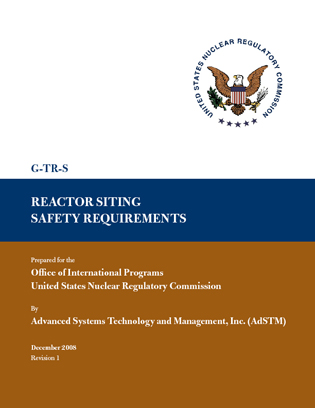G-TR-S Reactor Siting Safety Requirements

Table of Contents
- Introduction
- Definitions
- Objectives
- Scope
- Site safety requirements – an overview
- Site characteristics
- Radiological effects on the environment
- Non-seismic site hazards to plant safety
- Seismic hazards
- Emergency preparedness
- Security
- Monitoring
- Quality assurance
- References
Overview
These reactor siting safety requirements are based on, and were derived directly from, the International Atomic Energy Agency (IAEA) Safety Requirements No. NS-R-3: Site Evaluation for Nuclear Installation [1], Nuclear Regulatory Commission (NRC) Code of Federal Regulation (CFR) 10CFR part 100 [2]: Reactor Site Criteria, 10CFR part 52.17: Contents of Applications; Technical Information [3] and NRC 10CFR part 50. It includes often verbatim language from these regulations and requirements. This siting requirements document is intended to serve as a high level reference that can be implemented by the regulator according to the review guide G-RG-S, Reactor Siting: Risk-Informed Review Guide [4]. It is supplemented by the cited references such as IAEA Safety Guides, NRC Regulatory Guides, NRC regulations, and by NRC Review Standard RS-002 [14]. The references describe in sufficient detail how to implement the siting requirements. The references also describe in considerable detail the technical content that the regulator expects to review during the application of a site permit for the construction of nuclear installations (see Definitions).
These safety requirements are not categorized according to a specific reactor design, but rather as generic site-related safety requirements of nuclear power plants.
Siting factors and criteria are important in assuring that radiological doses from normal operation and postulated accidents will be acceptably low, that natural phenomena and potential man-made hazards will be appropriately accounted for in the design of the plant, that site characteristics are such that adequate security measures to protect the plant can be developed, and that physical characteristics unique to the proposed site that could pose a significant impediment to the development of emergency plans are identified.
The reactor siting consideration employs the traditional defense-in-depth approach to ensure public safety. Requirements for site evaluation are intended to ensure adequate protection of site personnel, the public and the environment from the effects of ionizing radiation arising from nuclear installations. It is recognized that there are steady advances in technology and scientific knowledge, in nuclear safety and in what is considered adequate protection. Safety requirements change with these advances and this document reflects the present consensus among States. It establishes requirements and provides criteria for ensuring safety in site evaluation for nuclear installations.
Siting away from densely populated centers has been and will continue to be an important factor in evaluating applications for site approval.
IAEA Safety Guides on site evaluation listed in references [5]-[13] and NRC Regulatory Guides [15]-[25], [27], [29]-[31] and Review Standard [14] provide recommendations on how to meet the requirements established in this Safety Requirements document. Additional information on siting requirements can be found in NRC regulations 10 CFR part 100 [2], 10CFR part 50 and 10CFR part 52.
